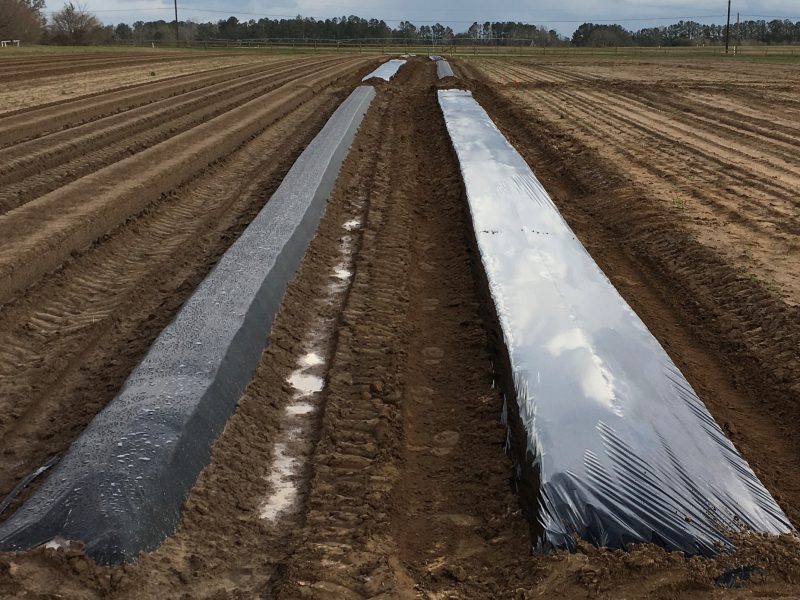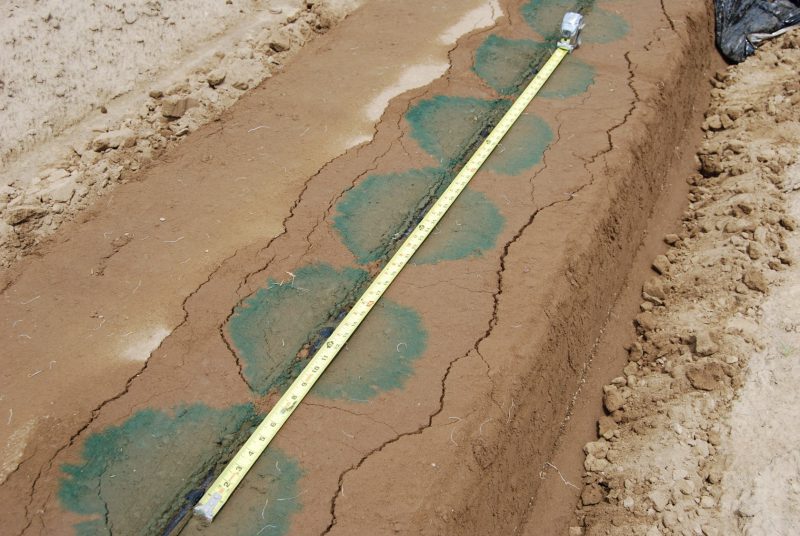Josh Freeman, UF/IFAS Vegetable Extension Specialist, North Florida Research and Education Center – Quincy
Have you ever sat back and wondered why some things we commonly use are designed the way they are? Let’s consider the bed design that we use for plasticulture produce production. Our most common bed design for many vegetable crops is 28-30” wide and 6-8” tall. If you’ve ever seen a dye study conducted that shows where the wetted area is from drip irrigation, you can see that much of that bed is not watered (Figure 1).
–
These areas eventually dry up and won’t support root growth and are essentially wasted space under plastic. One of the primary benefits of plasticulture is warming the soil in the spring, but a 30” wide bed isn’t necessary to warm the soil around a transplant that is grown in a 2” wide cell. Growers utilizing soil fumigation calculate fumigant rates based on the width of the bed so the wider the bed, the more fumigant that must be applied. Plastic mulch pricing is also based on the amount of plastic on a roll. For instance, a roll of 60” wide plastic is more expensive than a roll of 48” wide plastic, even though they both contain 4000’ of plastic. All this to point out that maybe plasticulture beds don’t need to be as wide as what has been traditionally used.
Growers are continually trying to improve economic efficiency and transitioning to a narrower plasticulture bed could provide input cost savings. Using a narrow tall bed has been researched by faculty at the University of Florida Southwest Florida Research and Education Center and implemented to some extent in that part of the state. Scientists at the North Florida Research and Education Center in Quincy began investigating alternative bed architecture during the spring of 2019. They compared beds 15” wide and 10” tall to beds 30” wide and 8” tall (Figure 2).

UF/IFAS Scientists compared productivity of plasticulture beds that were 15″ wide x 10″ tall(left) to 30″ x 8″ (right) beds at the North Florida Research and Education Center, Quincy, FL. Credit, Josh Freeman, UF/IFAS
–
We evaluated watermelon and tomato on these bed types. For tomato production we found no difference in plant growth or fruit yield between the narrow and wide beds. We also cooperated with local producers and put in two 5 acre test plots (Figure 3). Both growers were pleased with the results and mentioned that they could not tell a difference between standard and narrow beds. In our watermelon experiments we did observe reduced growth rate and yield when watermelons were grown on narrow beds, the reason for this difference is unclear. There are many cropping systems that utilize plasticulture and it is unclear how different crops will perform on the smaller beds. It would be advisable to evaluate compact beds on small acreage to determine if it is a fit for your operation. in addition to changing equipment, there are few other changes that need to be made to transition to compact beds.

5-acre on-farm tests were also utilized to compare bed design. Both commercial growers saw little difference in yields. Credit: Josh Freeman, UF/IFAS
–
Take Home Message
Transitioning to narrower beds would initially increas capital costs associated with in the form of new equipment to adop this technique. However, our cost analysis revealed that inputs costs of plastic and fumigant with narrow beds would be reduced by 30%, as compared to standard beds, which could save as much as $270 per acre for tomatoes. Our research group is continuing to evaluate compact plasticulture beds in 2020, but the results for tomato look promising. If you produce crops on plasticulture, this may be a strategy worth considering to reduce input costs.
- NFREC Faculty Tribute to Arnie Forrester - February 11, 2022
- Tomato Varieties for 2022 - January 28, 2022
- Pumpkin Production in North Florida - July 30, 2021

